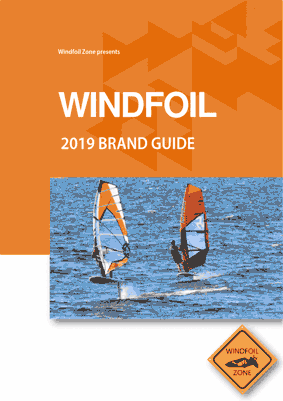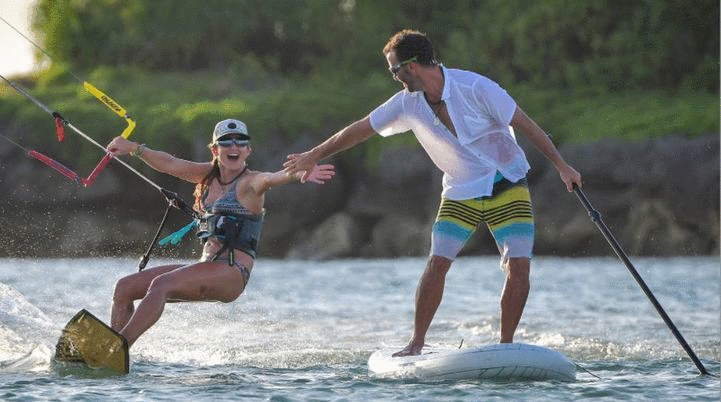THE BEST WINDFOIL TUNING TIPS
- Romain
- Feb 3, 2018
- 5 min read
Learn how to tune your windfoil equipment like a pro
Tuning you windfoil equipment is in many ways similar to regular windsurfing, the same principles apply. However, here are a few tips to make sure you get a comfortable ride for your first windfoil sessions.

How to find the best position for your mast foot?
In regular windsurfing, you have probably experienced that you need to put your mast forward when overpowered to better control your board, and in a backward position when underpowered, to get to get planning early.
The same principle is valid for windfoiling as well: By putting your mast foot forward, it will make your board stay closer to the water and will become calmer. You should feel much more in control. You will however experience the lift of the foil even if the board continues to touch the water often.
Putting the mast foot in a backward position will make the board fly more easily, but may be difficult to control. You need to find the sweet spot which will enable you to have a balanced flight. In many cases, it will be right in the middle of the mast foot rail, but finding the right spot is worth it for an optimal flight.
We recommend starting with the mast forward, and slowly move it backward to find the right place. That way you will avoid scary and uncontrolled flights.
As in regular windsurfing, you should also adjust the mast foot position depending on the wind conditions: if the wind increases, you should move the mast foot forward to have more control in your flight.

Renaud Barbier on his Mantafoils, in a comfortable position (Photo: Mantafoils)
The best footstraps hacks for windfoilers
When windfoiling, your body position is more upright on the board than in regular windsurfing. For that reason, you will want to move your feet away from the rail and more in the center of the board to avoid twisting your ankles. If your board has several insert options, you should place your footstraps more centered on the board, to get a more comfortable position.
Another hack is to open your footstraps slightly, giving your feet more freedom of movement.
At the beginning, we also highly recommend to remove the backstrap completely. You will need some time to find out where to place your back foot when learning how to windfoil. Removing the backstrap will help you find the right position for your back foot, without having to step on the footstrap.

Boom height
The boom height is an important factor to find balance on your foil. Depending on your level and weather conditions, you will adjust the height to get an optimal control of the board.
Having a low boom will increase the pressure on the mast foot and your board will stay closer to the water. You may prefer learning with a low boom, as you will feel the lift of the foil, but will stay close to the water and avoid hard falls. As in regular windsurfing, a low boom is also a good way to get more control of your board when overpowered.
On the other side, a high boom will make your board fly more easily. You will prefer a high boom when the wind is light, as it will help you to lift the foil effortlessly above the water, but also when you get more experience with your foil.

Rajko from Bug Fins & Foils cruising with a high boom and short harness lines
What is the right length for the harness lines?
The length of harness lines has always been a hot topic in windsurf. Some prefer long lines while others prefer short lines; it’s a matter of preferences. The debate may get a revival with windfoiling. As in regular windsurfing, there is no right or wrong size of harness lines in windfoil.
The right line length varies from person to person, it all depends of your weight, your height, your arm length, and of course the weather conditions. However, as your body is upright on a windfoil board, you will inevitably get closer to the sail, and your usual harness lines may appear to be too long.
We would suggest getting an adjustable set of lines so you can find out the right length for you. This will also enable you to easily move back and forth to longer lines when you use your rig for windsurfing again.

Philippe Caneri from Horue with mast foot in the middle and short harness lines
Tips for downhaul and outhaul trim – windfoiling versus windsurfing
First a small comment on the sail: You don’t need a specific windfoil sail to learn foiling, but it’s definitely nice to have! A windfoil sail such as the Loftsail Skyscape is lightweight, has a low aspect ratio (more of the sail area is low down), and a deep profile thanks to cambers. Such a sail enables you to get a very stable flight, even when the wind is light and the pressure on the sail is minimal. If you don’t want to buy a windfoil sail just yet, try to find a sail with these three features: light, compact, and with a camber.

Loftsail skyscape windfoil sail
As the wind pressure on the sail is much lower in windfoil, you will need to “keep the wind” inside the sail to get a propulsive force. This is the main difference between a sail tuned for windfoiling versus windsurfing. In other words, you don’t need so much downhaul trim as you want to keep a deep curve near the mast, and little tension on the leech (the outer edge of the sail). Using a sail with cambers is recommended, as it will to keep the draft near the mast even with low tension.
In windsurfing, we all learned that pulling harder on the downhaul will make the leech looser and enable to control the sail even in overpowered conditions. In windfoiling, being overpowered is usually not an enjoyable experience; lack of board control may result in a dangerous situation. Instead of increasing the downhaul trim, you would preferably take a smaller sail and get a more comfortable and pleasant flight.
The outhaul of your boom should only have a gentle trim, i.e. just enough to keep a nice curve on your sail. If you trim too hard, the sail will become flat and less effective, if you trim too little, the sail will touch the boom on the other side - which is equally ineffective.
The right tuning
By now, we hope you have figured out how to best tune your windfoiling equipment before heading out to the water and give it a try. These tips are based on our personal experience and you may not necessarily agree with all our advice.
Would you prefer to book a lesson with a windfoi, coach near you?
Try our Windfoil Directory, to find out where you can get windfoil courses with windfoiling experts.
If you have any questions or comments regarding the tuning of your windsurf foil equipment, don’t hesitate to drop a comment in the contact form or in the comments below.
Have a great flight!







Comments